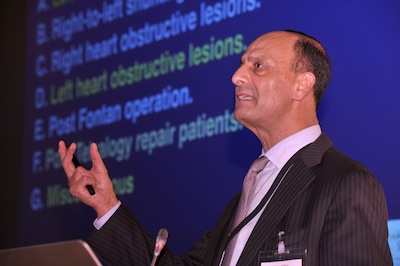Hi-tech heart surgery discussed at WCMC-Q’s Grand Rounds
June, 2015

Professor Ziyad M. Hijazi and his colleagues are able to safely
perform certain types of heart surgery using just local
anaesthetic.
One of the world’s leading cardiologists explained a variety of advanced interventional procedures used to treat adults with congenital heart disease in the latest installment of Weill Cornell Medical College in Qatar’s (WCMC-Q) Grand Rounds.
Professor Ziyad M. Hijazi, chief medical officer (acting) and chair of the Department of Pediatrics at Sidra Medical and Research Center, spoke about the latest developments in interventional therapies to repair common congenital and structural heart disorders such as atrial and ventricular septal defects (also known as hole in the heart), pulmonary valve stenosis (narrowing of the pulmonary valve), aortic valve stenosis (narrowing of the aortic valve) and patent foramen ovale, which is when an opening between the upper two chambers of the heart does not close after birth as it should.
Prof. Hijazi, who is also director of the Sidra Cardiovascular Center of Excellence, explained how cardiac interventionalists use advanced techniques, equipment and instruments to repair heart defects, often using a sophisticated catheter device to access the heart through an artery or vein in the groin, removing the need for opening the chest cavity.
Incredibly, Prof. Hijazi and his colleagues have refined a surgical procedure to repair an atrial septal defect (hole in the heart) to such a degree that it can now be safely performed under local anesthetic with the patient remaining conscious throughout. Each year, approximately 5,000 children are born with atrial septal defects in the United States alone. An estimated one million children and one million adults in the United States have some form of congenital heart disease.
Speaking at WCMC-Q to an audience of physicians, researchers, students and healthcare professionals, Prof. Hijazi said: “One of the nice things about the patient remaining conscious for this procedure is that we can now allow them to be accompanied by a loved one during the operation, which brings them great comfort. Additionally, because we are using local anesthetic, the patient can often return home the same day.”
In the procedure, Prof. Hijazi and his team use the catheter device to insert a special disc called an Amplatzer occluder made of braided nitinol – a sophisticated metal alloy of nickel and titanium - to close the hole between the two atria, allowing the heart to function normally. If left untreated, the hole causes more blood to flow to the lungs, which over time can cause the blood vessels there to become damaged. In adulthood this can lead to problems such as high pulmonary blood pressure, heart failure, electrical problems and increased risk of stroke.
Prof. Hijazi was the primary investigator who led the trials and pioneered the use and testing of Amplatzer occluders in the United States, leading to the device gaining approval from the United States Food and Drug Administration for use in children and adults. A prolific researcher, Prof. Hijazi has more than 290 peer-reviewed published articles to his name and has authored six books and more than 40 book chapters.
Prof. Hijazi said: “Approximately 10 percent of all congenital heart defects are atrial septal defects and in my experience more than 90 percent of cases can be repaired using a septal occluder device. For children and adults who are affected by this heart defect, making this repair can greatly improve their quality of life and also extend their lifetime, in some cases by many decades.”
Dr. Thurayya Arayssi, WCMC-Q’s associate dean of continuing professional development, said: “It is our great privilege to welcome Professor Hijazi here to explain a truly fascinating field of medicine to us. The development of highly advanced surgical techniques in the field of heart medicine, such as those pioneered by Dr. Hijazi, give hope to the millions of people worldwide whose lives are blighted by congenital and structural heart defects.”
